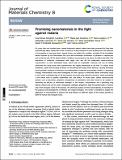Por favor, use este identificador para citar o enlazar a este item:
http://hdl.handle.net/10261/227422COMPARTIR / EXPORTAR:
 SHARE SHARE
 CORE
BASE CORE
BASE
|
|
| Visualizar otros formatos: MARC | Dublin Core | RDF | ORE | MODS | METS | DIDL | DATACITE | |

| Título: | Promising nanomaterials in the fight against malaria |
Autor: | Borgheti-Cardoso, Livia Neves; San Anselmo, María CSIC ORCID; Lantero Escolar, Elena; Lancelot, Alexandre; Serrano, José Luis CSIC ORCID; Hernández-Ainsa, Silvia CSIC ORCID; Fernàndez-Busquets, Xavier; Sierra, Teresa CSIC ORCID | Fecha de publicación: | 2020 | Editor: | Royal Society of Chemistry (UK) | Citación: | Journal of Materials Chemistry B 8(41): 9428-9448 (2020) | Resumen: | For more than one hundred years, several treatments against malaria have been proposed but they have systematically failed, mainly due to the occurrence of drug resistance in part resulting from the exposure of the parasite to low drug doses. Several factors are behind this problem, including (i) the formidable barrier imposed by the Plasmodium life cycle with intracellular localization of parasites in hepatocytes and red blood cells, (ii) the adverse fluidic conditions encountered in the blood circulation that affect the interaction of molecular components with target cells, and (iii) the unfavorable physicochemical characteristics of most antimalarial drugs, which have an amphiphilic character and can be widely distributed into body tissues after administration and rapidly metabolized in the liver. To surpass these drawbacks, rather than focusing all efforts on discovering new drugs whose efficacy is quickly decreased by the parasite's evolution of resistance, the development of effective drug delivery carriers is a promising strategy. Nanomaterials have been investigated for their capacity to effectively deliver antimalarial drugs at local doses sufficiently high to kill the parasites and avoid drug resistance evolution, while maintaining a low overall dose to prevent undesirable toxic side effects. In recent years, several nanostructured systems such as liposomes, polymeric nanoparticles or dendrimers have been shown to be capable of improving the efficacy of antimalarial therapies. In this respect, nanomaterials are a promising drug delivery vehicle and can be used in therapeutic strategies designed to fight the parasite both in humans and in the mosquito vector of the disease. The chemical analyses of these nanomaterials are essential for the proposal and development of effective anti-malaria therapies. This review is intended to analyze the application of nanomaterials to improve the drug efficacy on different stages of the malaria parasites in both the human and mosquito hosts. | Versión del editor: | https://doi.org/10.1039/D0TB01398F | URI: | http://hdl.handle.net/10261/227422 | DOI: | 10.1039/D0TB01398F | E-ISSN: | 2050-7518 |
| Aparece en las colecciones: | (INMA) Artículos (CIN2) Artículos |
Ficheros en este ítem:
| Fichero | Descripción | Tamaño | Formato | |
|---|---|---|---|---|
| promismalari.pdf | 5,49 MB | Adobe PDF |  Visualizar/Abrir |
CORE Recommender
WEB OF SCIENCETM
Citations
28
checked on 27-feb-2024
Page view(s)
107
checked on 18-abr-2024
Download(s)
103
checked on 18-abr-2024
Google ScholarTM
Check
Altmetric
Altmetric
Este item está licenciado bajo una Licencia Creative Commons

